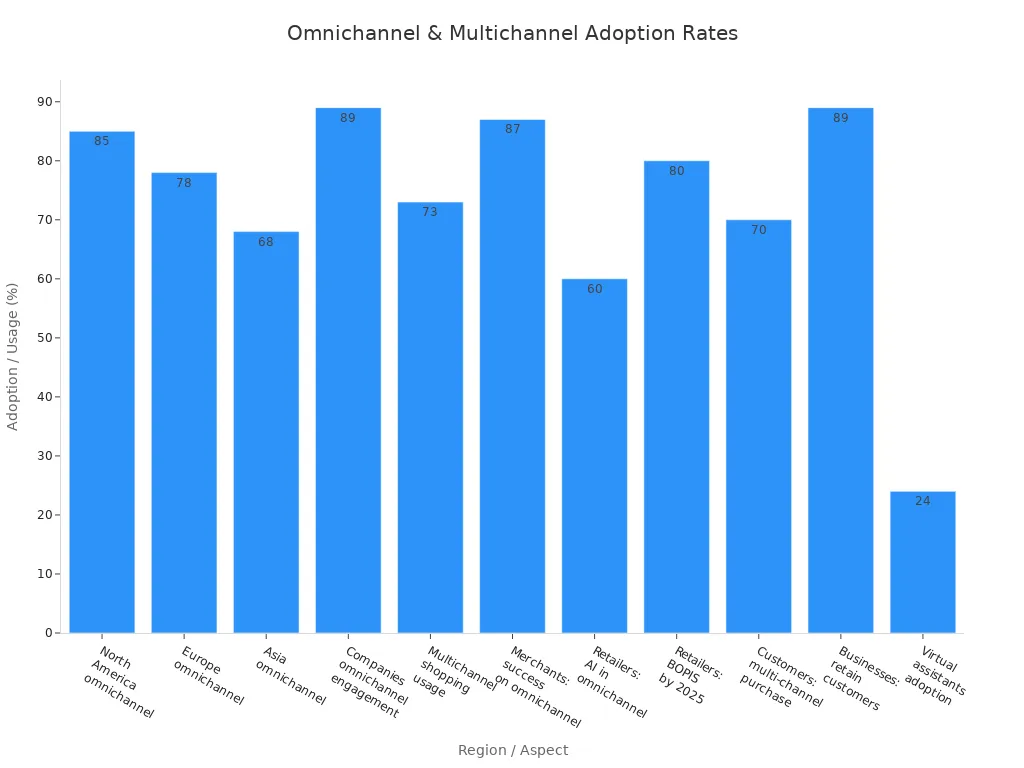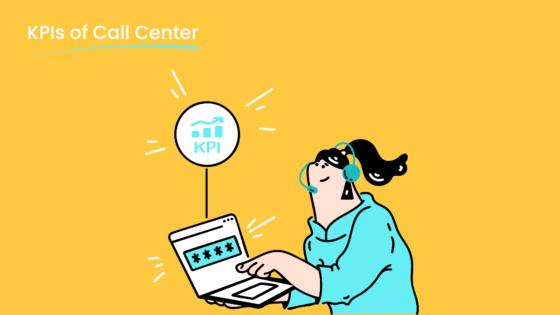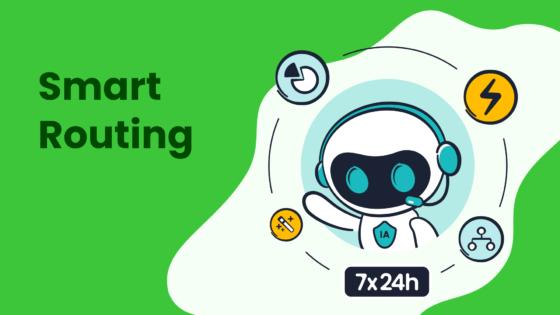Essential Tips for Implementing Omnichannel vs Multichannel Support

Choosing how you support customers can shape your whole business. Omnichannel means you connect every channel, so your customer never has to repeat themselves. Multichannel gives options, but each channel stands alone. This difference affects customer experience and business results in big ways. Just look at the numbers—up to 91% higher retention with omnichannel, and 85% of North American retailers already use it.

With Sobot and Sobot AI, you get advanced tools to create seamless customer journeys. If you want to see real results, understanding omnichannel vs multichannel customer service is the first step.
Key Differences

Omnichannel Customer Service
Omnichannel customer service connects all your channels into one smooth system. You can start a chat on a website, switch to email, and then call support—your information follows you every step. This approach creates a seamless customer experience because agents see your full history and know your preferences. You never have to repeat yourself.
Here’s what makes omnichannel stand out:
- All channels—like live chat, phone, email, social media, and messaging apps—work together.
- Your journey stays consistent, no matter where you reach out.
- Agents use a unified workspace, so they always have your details handy.
- AI-powered chatbots and smart routing help solve problems faster.
Sobot’s omni-channel customer service platform brings all these features together. With Sobot, you get a single source of truth for every customer, making each interaction feel personal and efficient. This strategy boosts loyalty and keeps customers coming back.
Multichannel Customer Service
Multichannel customer service gives you choices. You can call, email, or use social media, but each channel stands alone. If you switch from chat to phone, you might have to explain your problem again. The channels don’t share information, so your experience can feel disconnected.
Key points about multichannel:
- Each channel operates separately.
- Customers get flexibility, but not always consistency.
- Agents may not see your full history across channels.
- Easier to set up, but can lead to repeated questions.

Sobot’s Voice/Call Center is a great example of a flexible solution for managing multiple channels. It helps you handle calls and messages efficiently, even if you’re not ready for full integration.
Tip: Think about your customer’s journey. Do they want a smooth, connected experience, or just more ways to reach you?
Why It Matters
The choice between omnichannel vs multichannel customer service shapes your entire customer experience. Studies show that businesses using omnichannel strategies see 91% higher customer retention rates (source). Customers expect brands to remember their history and provide consistent support. If you deliver a seamless journey, you build trust and loyalty. If you don’t, customers may switch to a competitor.
| Aspect | Multichannel Customer Service | Omnichannel Customer Service |
|---|---|---|
| Integration | Channels operate separately without sharing customer data. | All channels are integrated, sharing customer history and context. |
| Consistency of Experience | Customers may face inconsistent service and repeat information. | Provides a seamless, consistent experience across all channels. |
| Customer-Centricity | Focuses on offering multiple communication options. | Focuses on the entire customer journey with connected touchpoints. |
| Technology & Training | Simpler technology, less complex training required. | Requires advanced technology and training for integration. |
| Customer Benefit | Convenience of choice but isolated experiences. | Enhanced personalization, efficiency, and loyalty through continuity. |
Choosing the right strategy helps you meet customer needs and grow your business. Sobot’s omni-channel customer service solutions make it easy to deliver the experience today’s customers expect.
Omnichannel Tips
Integrate All Channels
You want every customer to feel like they’re talking to one brand, no matter which channel they use. Integrating multiple channels is the first step in a successful omnichannel strategy. Here’s how you can do it:
- Start by understanding what your customers need and which channels they use most.
- Choose an omnichannel platform that brings all your customer contact points together. Sobot’s omnichannel solution gives you a unified workspace, so your team can see every message, call, or chat in one place.
- Train your team to handle questions across all channels with empathy and speed.
- Make sure customers can switch from chat to email or phone without repeating themselves. This creates a seamless customer experience and keeps customers engaged.
- Use analytics to track how well your channels work together and spot areas for improvement.
When you connect every channel, you build better customer experiences and boost customer retention. Opay, for example, used Sobot to bring social media, email, and voice into one system. Their customer satisfaction jumped from 60% to 90%. That’s the power of a successful omnichannel strategy.
Unified Customer Data
Unified customer data is the secret sauce behind great omnichannel customer contact. When you pull all customer information into one system, your agents can see the full journey—every chat, call, and email. This means no more asking customers to repeat themselves.
With Sobot’s omnichannel solution, you get a single view of each customer. The platform uses advanced CRM and AI tools to keep everything in sync. This helps you deliver personalized service, solve problems faster, and increase satisfaction. You also gain insights to improve your omnichannel content strategy and target the right people at the right time.
Unified data supports a consistent customer experience and makes your team more efficient. It’s a must-have for any successful omnichannel strategy.
Consistent Experience
Customers expect a consistent customer experience every time they reach out. You can make this happen by setting clear guidelines for messaging, tone, and service standards. Sobot’s unified workspace helps your team stay on the same page, no matter which channel they use.
Here are some customer service best practices for consistency:
- Use the same brand voice and helpful attitude everywhere.
- Integrate your systems to avoid data silos.
- Train your team to deliver seamless experiences across all channels.
- Monitor quality and satisfaction metrics to catch issues early.
A consistent approach builds trust and loyalty. It also supports a successful omnichannel strategy and helps you deliver cohesive customer experiences.
Customer Journey Mapping
Mapping the customer journey lets you see every step your customers take. You can spot where they get stuck or frustrated and fix those pain points. This is key for a successful omnichannel strategy.
Customer journey mapping tools help you visualize all the touchpoints—chat, calls, emails, and even in-store visits. Sobot’s analytics and AI features make it easy to track behaviors and spot trends. You can personalize support, route questions to the right agent, and keep customers engaged.
When you understand the full journey, you create seamless omnichannel experiences and improve customer satisfaction. Companies like Starbucks and Spotify use journey mapping to fix problems and keep customers coming back.
Team Training
Your team needs the right training to deliver a great omnichannel customer service experience. Start with a mix of classroom lessons, online courses, and hands-on practice. Make sure everyone knows how to use your omnichannel platform and understands each channel.
Ongoing training keeps your staff up to date on new tools and customer expectations. Sobot offers resources and support to help your team master the platform. When your team feels confident, they deliver seamless experiences and support your successful omnichannel strategy.
Feedback and Analytics
Feedback and analytics drive continuous improvement in omnichannel customer contact. You should collect feedback from surveys, social media, and reviews. Use AI-powered tools to spot trends and understand what customers really want.
Sobot’s omnichannel solution gives you over 300 reports and thousands of indicators. You can track key metrics like:
| Metric | Why It Matters |
|---|---|
| Customer Satisfaction Score (CSAT) | Shows how happy customers are with your service |
| Net Promoter Score (NPS) | Measures loyalty and likelihood to recommend you |
| Customer Retention Rate (CRR) | Tracks how many customers stick with your brand |
| Cross-Channel Journey Analytics | Reveals how customers move between channels |
| Multi-Channel Engagement Rate | Shows which channels keep customers engaged |
Share these insights with your team and use them to refine your omnichannel content strategy. This helps you deliver seamless experiences, improve satisfaction, and grow your business.
Multichannel Tips
Choose the Right Channels
You want to meet your customers where they are. Start by looking at the platforms your audience uses most. For many businesses, this means starting with big names like Google and Facebook, then adding channels that fit your industry. Use analytics to see which channels get the most engagement and adjust your mix as you learn more.
Sobot’s Voice/Call Center makes it easy to manage calls, emails, and social media from one place. This flexibility helps you reach customers on their favorite platforms. When you pick the right channels, you save time and money while giving your customers more ways to connect. Remember, the best omni-channel customer service starts with smart channel choices.
Channel-Specific Best Practices
Each channel has its own style. You need to match your approach to the channel. Here’s a quick guide:
| Channel | Best Practices |
|---|---|
| Phone | Speak clearly, listen well, and solve problems in real time. |
| Write clear, helpful messages. Respond quickly, even if just to say you’re working on it. | |
| Live Chat | Be fast and friendly. Use short sentences and answer questions right away. |
| Social Media | Stay positive and on-brand. Respond to comments and messages quickly to keep customers happy. |
You can use Sobot’s Voice/Call Center to manage all these channels. It supports omni-channel customer service by giving you tools for each type of interaction. Following customer service best practices for every channel keeps your service strong and your customers satisfied.
Manage Data Silos
Data silos can slow you down. When information is stuck in separate systems, your team can’t see the full customer journey. This means customers might have to repeat themselves, which nobody likes.
To fix this, use a platform that brings all your data together. Sobot’s Voice/Call Center connects calls, emails, and self-service channels in one place. This helps your team see everything they need to help customers fast. Breaking down silos leads to smoother omni-channel customer service and happier customers.
Channel Training
Your team needs special training for each channel. Phone calls need strong listening skills. Emails need clear writing. Social media needs quick, friendly replies.
Try hands-on learning, like role play or real-life practice. Make training fun with games or rewards. Give your team quick guides and support tools for real-time help. Sobot offers resources to help your agents get comfortable with every channel. When your team feels ready, they deliver better omni-channel customer service across all self-service channels.
Separate Analytics
You should track how each channel performs. Look at things like response times, customer satisfaction, and common questions. Use real-time analytics to spot problems fast and historical data to plan for the future.
Sobot’s Voice/Call Center gives you detailed reports for every channel. You can see which self-service channels get the most use and where customers need more help. Use these insights to improve scripts, train your team, and make smart changes. Good analytics help you build a stronger omni-channel customer service strategy.
Omnichannel vs Multichannel Customer Service

Comparison Table
Let’s start with a quick look at how omnichannel vs multichannel customer service stack up side by side:
| Feature | Multichannel Customer Service | Omnichannel Customer Service |
|---|---|---|
| Focus | Multiple separate channels, each with its own goals. | Unified channels for a seamless customer journey. |
| Customer Experience | Fragmented; customers repeat info. | Smooth, continuous, and personalized support. |
| Channel Integration | Channels don’t share data. | Channels are fully integrated and share data. |
| Data and Analysis | Data is siloed per channel. | Data is unified for a 360-degree view. |
| Implementation | Easier to set up. | Needs more tech and planning. |
You can see that omnichannel puts the customer at the center, while multichannel focuses on offering more options.
Integration
When you use multichannel, each channel stands alone. Your phone, email, and chat don’t talk to each other. This means your team only sees part of the story, and customers often repeat themselves. Omnichannel brings everything together. All channels connect in one system, so your team sees every interaction. Sobot’s platform does this by giving you a unified workspace. You can switch from chat to call without losing context. This makes your strategy much stronger and keeps the customer journey smooth.
Data Management
Managing data is a big challenge in both strategies. In multichannel, data gets stuck in silos. Your team misses the full picture, and mistakes happen. Omnichannel solves this by unifying customer data. You get real-time updates and a single view of every customer. Sobot uses AI and cloud technology to keep your data clean and connected. This helps you deliver better customer experience and boost satisfaction.
- Omnichannel needs more setup, but you get a 360-degree view.
- Multichannel is simpler, but you risk losing important info.
Customer Experience
Customer experience is where omnichannel vs multichannel customer service really shows its impact. Omnichannel lets customers move between channels without repeating themselves. For example, Starbucks links its app, loyalty program, and stores for a seamless journey. Multichannel can leave customers frustrated, like when they have to start over on a new channel. Surveys show that omnichannel strategies lead to higher customer satisfaction and loyalty. You want your strategy to make every experience easy and personal.
Scalability
As your business grows, you need a strategy that scales. Omnichannel helps you handle more customers by using AI, automation, and smart routing. You can keep service quality high, even with more volume. Sobot’s omnichannel solution supports this with features like automated ticketing and unified analytics. Multichannel can struggle to keep up, since each channel needs separate management. Omnichannel vs multichannel customer service isn’t just about today—it’s about growing with your customers.
Choosing Your Approach
Assess Customer Needs
You want your support to match what your customers expect. Start by mapping the customer journey. Look at every touchpoint and see where people switch channels. Ask yourself why they switch. Are they looking for faster answers or a more personal touch? This helps you spot friction points.
- List all the channels your customers use.
- Check if they have to repeat information when moving between channels.
- Find out which channels get the most questions or complaints.
Tip: A simple audit can reveal if you need a basic multichannel setup or a full omnichannel experience. If your customers want smooth, connected service, an omnichannel strategy will help you stand out.
Here’s a quick table to help you compare:
| Factor | Multichannel Focus | Omnichannel Focus |
|---|---|---|
| Customer Experience | Choice of channels | Seamless journey |
| Data | Siloed | Unified |
| Integration | Low | High |
Evaluate Technology (Sobot)
Choosing the right technology makes your strategy work. Sobot gives you an all-in-one platform with AI tools that automate tasks and personalize every customer interaction. With Sobot, you get a unified workspace, voicebots, chatbots, and analytics—all in one place.
- Sobot’s AI agents handle questions 24/7 across all channels.
- The platform supports multilingual service and scales as you grow.
- You can connect Sobot with your CRM for a single view of each customer.
Companies like Agilent saw a 6x boost in efficiency and cut costs by 25% after using Sobot’s AI-powered omnichannel solution. The system keeps improving with the latest AI updates, so your customer service stays future-ready. By 2025, experts predict 95% of customer interactions will use AI (source).
Plan for Growth
You want your strategy to grow with your business. Start by setting clear goals for your customer service. Use SMART goals—Specific, Measurable, Attainable, Relevant, and Time-bound. Map the customer journey again as your business changes.
- Align your strategy with your business goals.
- Use analytics to track what works and what needs fixing.
- Train your team to handle new channels and tools.
- Build cross-team support so everyone works together.
- Keep testing and improving your approach.
Sobot’s omnichannel platform makes it easy to add new channels and scale up without losing quality. You can start small and expand as your needs grow. This way, your customer service stays strong, no matter how big your business gets.
You’ve seen how omnichannel connects every channel for a seamless customer experience, while multichannel keeps channels separate. Omnichannel gives you faster resolutions, personalized service, and higher customer loyalty. Multichannel offers flexibility but can feel disconnected. To improve your support, listen to your customers, use real-time feedback, and train your team. Sobot’s solutions help you unify channels and boost satisfaction. Ready to level up your customer experience? Start by reviewing your current support channels and see where you can make things smoother.
FAQ
What is the main difference between omnichannel and multichannel customer service?
Omnichannel customer service connects all your channels, so your customer journey feels smooth and unified. Multichannel gives choices, but each channel stands alone. With omnichannel, you never repeat yourself. Sobot’s platform makes this easy by bringing every message, call, and chat into one workspace.
How does Sobot help improve my customer journey?
Sobot’s omni-channel customer service solution gives you a unified workspace. You see every customer’s history, no matter the channel. This means faster answers and happier customers. For example, Opay boosted satisfaction from 60% to 90% after using Sobot’s omnichannel tools.
Why should I care about unified customer data?
Unified data lets you see the whole customer journey. You spot problems fast and personalize every reply. Sobot’s omnichannel customer service platform keeps all your info in one place. This helps you solve issues quickly and build trust with your customers.
Can I start with multichannel and move to omnichannel later?
Yes! Many businesses begin with multichannel support. As your needs grow, you can switch to omnichannel customer service. Sobot’s solutions scale with you. You add new channels and keep your customer journey smooth as your business expands.
Tip: Start by mapping your customer journey. This helps you see where omnichannel customer service can make the biggest impact.
See Also
How To Successfully Deploy Omnichannel Contact Center Systems
Comprehensive Overview Of Omnichannel Call Center Platforms
Step-By-Step Process For Using Shopify Live Chat Support
